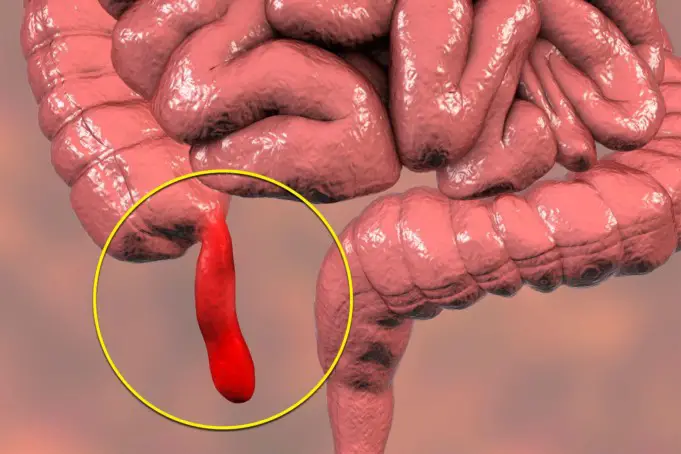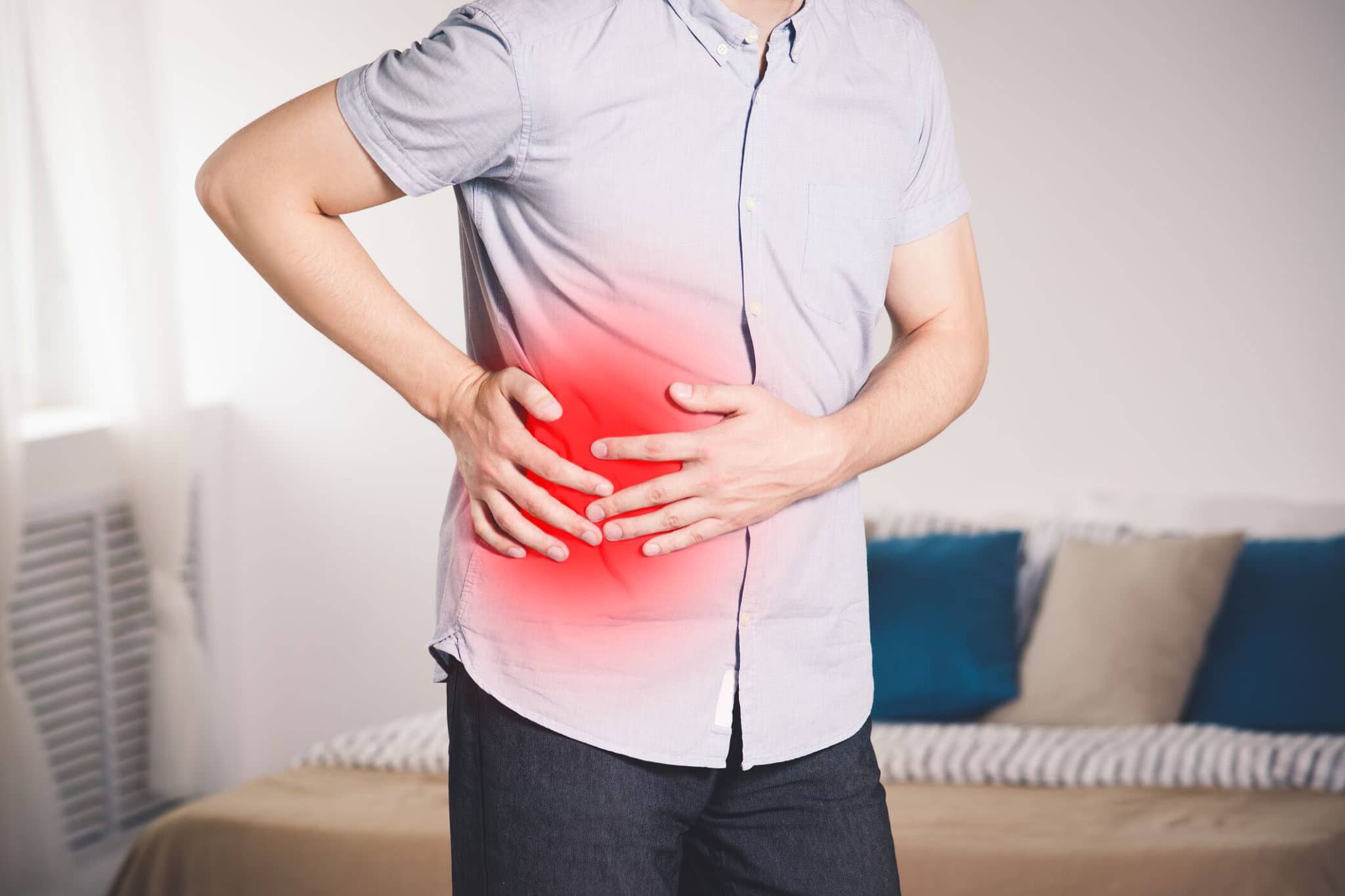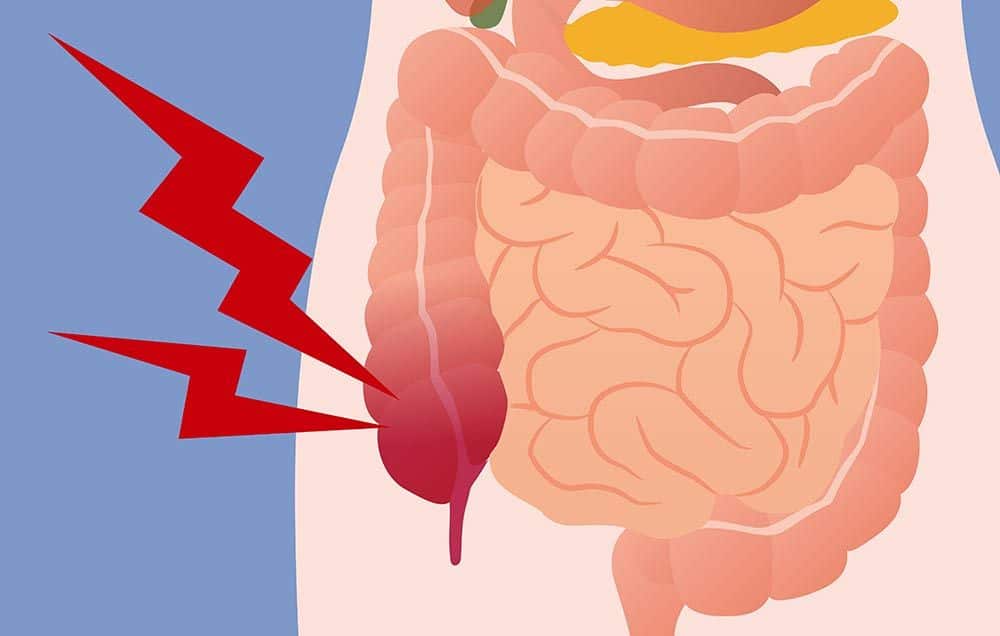Appendicitis is a condition whereby there is an inflammation of the appendix, in which the appendix is inflamed and filled with pus, which can be very painful. It’s a medical emergency that almost always requires surgery as soon as possible to remove the appendix.
The appendix is a small finger-like tube connected to the cecum, from which it develops during fetal development. The cecum is a pouch-like organ of the colon, located at the intersection of the small and the large intestine, in the lower right abdomen.
The Lymphatic tissue in the appendix assists in immune function. The official name of the appendix is a vermiform appendix, which translates to “like a worm appendage.” The appendix is believed to harbor bacteria.
Previously, the appendix was believed to have little physiological or no function. But recent studies have established, the appendix serves a significant role in the fetal stage and young adults.
The Endocrine cells appear in the appendix, in a fetus at around the first trimester of development; these cells of the fetal appendix have been discovered to produce several biogenic amines and peptide hormones, compounds that aid various biological control or homeostatic mechanisms.
There had been little preliminary evidence of this or any other function of the appendix in research, maybe because the appendix doesn’t exist in domestic animals.
Among adults, the appendix is now assumed to be involved predominantly in immune processes. Lymphoid tissue begins to amass in the appendix shortly after delivery and attains a climax between the second and third decades of living, reducing quickly subsequently and virtually disappearing after the age of 60.
During the initial years of development, the appendix has been revealed to function as a lymphoid organ, helping with the maturation of B lymphocytes, which is a variety of the white blood cell and in the creation of the class of antibodies known as immunoglobulin A antibodies.
Scientists have also discovered that the appendix is included in the production of molecules that regulate the movement of lymphocytes to various other body sites.
The appendix appears to be responsible for exposing white blood cells to antigens, or foreign substances, existing in the gastrointestinal tract.
Nevertheless, the appendix presumably helps to quell potentially destructive humoral antibody responses while facilitating a naturally acquired immunity to a virulent agent that is restricted to a specific organ or tissue.
Formerly, the appendix was often randomly extracted and disposed of during other abdominal surgeries to deter any likelihood of a later attack of appendicitis; the appendix is then spared in case it is required for reconstructive surgery in the event of the removal of the urinary bladder.
In such an operation, a portion of the intestine is designed into a replacement bladder, and the appendix is utilized to re-create a sphincter muscle so that the patient remains capable of urine retention.
In extension, the appendix has been successfully reconstructed into a substitute replacement for a diseased ureter, enabling urine to flow from the kidneys to the bladder.
Consequently, the appendix, once considered a nonfunctional tissue, is now known as a valuable substitute that can be utilized in an assortment of reconstructive surgical procedures. It is no longer habitually removed and discarded, especially when it is healthy.
Causes of Appendicitis
Appendicitis is caused by a blockage of the open portion of the appendix. This is due to gallstones or tumors, hardened and calcified material made of feces, Inflamed lymphoid tissue from a viral infection, and parasite, which can result in the blockage.
This blockage can lead to bacterial growth, which can cause inflammation inside the appendix, heightened pressures in the appendix, reduced blood flow to the tissues of the appendix.
The combined effect of inflammation and reduced blood flow to the appendix can cause tissue trauma and subsequent tissue death.
If this condition is left untreated, the appendix may rupture releasing bacteria into the abdominal cavity, which can cause complications.
Appendicitis is one of the most established causes of severe and rapid abdominal pain. In the survey carried out in 2015, about 11.6 million cases of appendicitis occurred around the world.
In the United States, appendicitis is the most prevalent cause of sudden abdominal pain, which usually requires surgery. Reginald Fitz is indicated with being the first person to define this condition in 1886.
About 5% of the population develops appendicitis at some point in their lifetime. Annually in the United States, about 300,000 people with appendicitis have their appendix surgically removed.
Appendicitis most typically occurs during adolescence and in the 20s to 30s, although it can occur at any age. The cause of the inflammation of the appendix is not entirely understood.
However, in most cases, a blockage in the appendix possibly started the process. The blockage may be from a foreign body, a small hard piece of stool, or, rarely, even worms.
Due to the effect of the blockage, the appendix can become swollen and infected. If this inflammation continues without treatment, the appendix can rupture. A ruptured appendix may cause a pus-filled infection (abscess) to form.
Consequently result in the inflammation and usually infection of the abdominal cavity, which can cause a life-threatening disease to develop.
In women, the ovaries and fallopian tubes can also become affected and may result in scarring, which can obstruct the fallopian tubes and cause infertility.
A ruptured appendix can also enable bacteria to infect the bloodstream, which is a life-threatening condition known as sepsis.
Symptoms of Appendicitis
The definitive symptoms of appendicitis include:
- Sudden, chronic pain the lower right belly or pain near the navel that moves lower, which is usually the first sign.
- Loss of appetite and eating disorders
- Nausea and vomiting
- Swollen belly
- Fever
- Inability to pass gas
How Is Appendicitis Diagnosed?
Examination by a doctor or a healthcare specialist will include;
- Imaging tests
- Laparoscopy
- Blood test
The diagnosis of appendicitis is generally based on the person’s signs and symptoms. A doctor may assume appendicitis after examining the person’s symptoms and conducting a physical examination of the abdomen.
Usually, surgery is done immediately if the doctor strongly suspects appendicitis.
In cases where the diagnosis is uncertain, close observation, medical imaging, and laboratory tests can be useful.
The two most widely used imaging tests used are ultrasound (Ultrasonography) and computed tomography (CT scan). Doctors usually do imaging tests such as computed tomography (CT) or ultrasonography.
Ultrasonography is particularly useful in children and pregnant women, in whom it is essential to limit radiation exposure from CT scans to reduce the risk of future cancers, although a CT scan has been ascertained to the most accurate and reliable type of medical imaging test available in detecting acute appendicitis.
Surgeons can also carry out a laparoscopy to inspect the abdominal cavity and help with the diagnosis.
A blood test often indicates a moderate increase in the white blood cell count because of the infection, but there is no specific blood test for appendicitis.
What Is the Treatment for Appendicitis
- Surgical extraction of the appendix
- Antibiotics and fluids intravenously
Surgery is the primary treatment of appendicitis. Prompt medical treatment is paramount in the treatment of appendicitis as delaying surgery until the cause of the abdominal pain is defined can be fatal: An infected appendix can rupture less than 36 hours after symptoms start.
If appendicitis is found, fluids and antibiotics are given by vein, and the appendix is removed in a process called an appendectomy. If the doctor does operation and appendicitis is not found, the appendix can be removed anyway to prevent any future risk of a future inflammation.
There has been a recent study and interest in treating appendicitis with antibiotics, especially in some cases of non-ruptured appendicitis.
So that surgery can be postponed or avoided or used at the last treatment option. Although this treatment may be successful in some people, it is still being studied, and surgical removal of the appendix is always assumed to be advised standard treatment option for appendicitis.
An open incision may do this in the abdomen (laparotomy) or via a few minor incisions with the aid of cameras (laparoscopy). Surgery reduces the risk of side effects or death associated with the rupture of the appendix.
What to Expect During an Appendectomy
Before the appendix is taken out, one will be prescribed antibiotics to fight infection. One usually get general anesthesia, meaning they will be asleep for the procedure.
The doctor then extracts the inflamed appendix through a 4-inch-long cut or with a device called a laparoscope (a thin telescope-like tool that lets them see inside your belly).
This procedure is called a laparoscopy. If you have peritonitis, the surgeon will also clean out your belly and drain the pus.
One should be able to get up and move around within 12 hours after surgery. And should be able to go back to one’s normal routine in 2 to 3 weeks. If one had a laparoscopy, recovery is faster.
After an appendectomy, one should inform the doctor if one has:
- Uncontrolled vomiting
- Increased belly pain
- Dizziness/feelings of faintness
- Blood in your vomit or pee
- Increased pain and redness where your doctor cut into your belly
- Fever
- Pus in the wound
Appendicitis Complications
If left untreated, an inflamed appendix will burst, spilling bacteria and debris into the abdominal cavity, the central part of your body that holds your liver, stomach, and intestines.
This can lead to peritonitis, a serious inflammation of the abdominal cavity’s lining (the peritoneum). It can be deadly unless it is treated quickly with strong antibiotics.
Sometimes, an abscess forms outside an inflamed appendix. Scar tissue then “walls off” the appendix from the rest of your organs. This keeps the infection from spreading. But an abscessed appendix can tear and lead to peritonitis.
Appendicitis Prevention
There’s no way to prevent appendicitis. But it may be less common in people who eat foods high in fiber, such as fresh fruits and vegetables.















